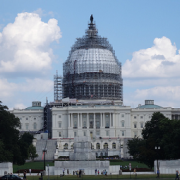Autonomous Tech Scales Capitol Hill
Burney Simpson
The autonomous transportation industry brought its game to Capitol Hill this week, holding a nearly all-day event that featured speeches from a U.S. Senator, four Congressmen, and a number of driverless leaders, all over the course of a luncheon, a seminar, and a showcase event/cocktail party with several dozen of the top firms in the business.
Not bad for a day’s work.
Trade group ITS America put on ‘The Future of Mobility: Rethinking Transportation for the Next 30 Years’ and garnered the participation of Sen. Gary Peters, a Michigan Democrat, and Representatives Earl Blumenauer, an Oregon Democrat, Rodney Davis, an Illinois Republican, and Peter DeFazio, a Democrat from Oregon.
While much of the conversation was positive and friendly, a few of the seminar panelists took the opportunity to raise issues that Congress may have to address someday.
- Data Privacy and Security — Daniel Morgan, chief data officer with the US Department of Transportation, noted that the security and privacy of citizen travel data was essential but that the information could be beneficial for metropolitan planners. Morgan floated the idea that a third party firm be responsible for collecting and storing the data if people objected to the federal government holding it.
- Reserving DSRC wavelength for V2V and V2I — Alan Korn, an executive with heavy-truck parts supplier Meritor WABCO, said the Dedicated Short-Range Communications 5.9 GHz spectrum must be reserved for Vehicle-to-Vehicle and Vehicle-to-Infrastructure communications to ensure autonomous driving safety. Later, Sen. Peters said that new technology may allow for the sharing of the 5.9 spectrum with other Wi-Fi users.
- Driverless Timeline — Supplying a welcome dose of reality was Tom Dingus, director of the Virginia Tech Transportation Institute (VTTI). Dingus said developing a truly autonomous system would be considerably more difficult and probably take longer than some recent studies and press reports suggest. Driverless vehicles will have to be safer than the much-maligned human driver but consider that the average human has one rear-end crash every 25 years, and makes 3 million braking decision in that time, said Dingus. “It is very difficult to build a system that is that robust,” said Dingus.
The exhibition hall featured 22 organizations involved with autonomous transportation development, including Eberle Design, Econolite, GM, Iteris, the University of Michigan Mobility Transformation Center, NXP Semiconductors, Southwest Research Institute, and Uber.
VTTI was there too taking a bit of a victory lap after its successful demo this week on a nearby highway of its driverless Cadillac SRX. The ride along featured Sen. Mark Warner, a Virginia Democrat, and generated extensive media coverage (See “Virginia Seeks Autonomous Research Lead,” October 20, 2015).
The showcase garnered a little more exposure for the technology with another half-dozen members of Congress visiting the exhibit hall to check out the firms on display, according to an ITS spokesperson.
The day also offered an exhibit of a DeLorean car from an old movie that predicted people would fly on skateboardy-type things. This fascinated a number of Gen-Yers and Millennials who took selfies.
Photo: United States Capitol, 2015, Matt C.

